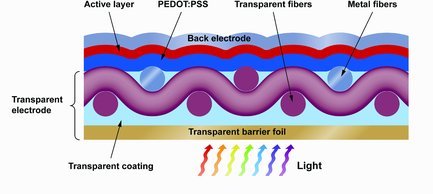| Transparent electrodes represent an enabling technology for flexible electronics encompassing a range of product applications for both consumers and critical national needs, including displays, solar photovoltaics (PV), e-paper, and light emitting diodes (LEDs). Recently, Kylberg et. al. reported on the investigation of transparent, flexible electrodes based on a precision fabric using metallic and polymer fibers woven into a mesh configuration. In this paper, Transparent electrodes have been demonstrated using a precision woven mesh approach that enables subsequent integration of flexible electronic devices. The woven fabric mesh can be further optimized for conductivity and transparency through control of the metallic to polymer fiber ratios and spacing, and the follow-on polymer gap filling step. High rate scaled processing of these woven fabrics have already been demonstrated with roll-to-roll process speeds of 10 m/min achieved. Thus an ITO free transparent electrode approach has been demonstrated with the potential to impact future flexible electronics technology. |
Reviewed by Jeff Morse, PhD, National Nanomanufacturing Network
- Kylberg W, Araujo de Castro F, Chabrecek P, Sonderegger U, Tsu-Te Chu B, Nuesch F, Hany R. 2011. Woven electrodes for flexible organic photovoltaic cells. Advanced Materials. 23(8):1015-1019. doi:10.1002/adma.201003391
Transparent electrodes represent an enabling technology for flexible electronics encompassing a range of product applications for both consumers and critical national needs, including displays, solar photovoltaics (PV), e-paper, and light emitting diodes (LEDs). While indium tin oxide (ITO) is the prevalent material of choice for existing flat panel display and touch-screen markets, ITO is less desirable for emerging flexible applications as increasing demand will lead to limited supply which will ultimately drive cost up. In addition, the brittleness of ITO thin films have a tendency to crack and fail under bending and flexing. Furthermore, TTO deposition requires vacuum coating techniques, and subsequent high-temperature anneal steps that are not compatible with plastic substrates and scalable to high throughput roll-to-roll or printing processes. Alternate approaches to achieve transparent electrodes for flexible substrates have investigated the use of polymers loaded with conductive nanostructures such as graphene, carbon nanotubes (CNTs), and metallic nanowires or nanoparticles. Further approaches include thin films of graphene, pre-patterned metallic grids, or conductive polymers such as poly(3,4-ethylenedioxythiophene)/poly(styrene sulfonic acid) (PEDOT:PSS). These techniques have provided transparency on the order of 75-85%, with conductivities in the 10-200 Ω/square range. While these parameters are sufficient for some flexible electronics applications, the resistive losses remain too high for many scaled applications. Furthermore, the morphology of the electrode films leads to other issues impacting device performance, such as excessive leakage current in diode structures.

Organic solar cells were fabricated from the woven fabric transparent electrodes and compared to similar devices fabricated using ITO on glass. The cell performance with woven fabric electrodes compared very well with the cells having ITO transparent electrodes, both in efficiency and open circuit voltage, indicating no losses due to shorting. Subsequent bending tests of devices formed on the woven mesh electrodes compared favorably to devices formed from ITO coated onto plastic substrates, with the ITO exhibiting significant reduction in conductivity after only a few bends, whereas the woven fabric exhibited little or no degradation after 100 bends.
Transparent electrodes have been demonstrated using a precision woven mesh approach that enables subsequent integration of flexible electronic devices. The woven fabric mesh can be further optimized for conductivity and transparency through control of the metallic to polymer fiber ratios and spacing, and the follow-on polymer gap filling step. High rate scaled processing of these woven fabrics have already been demonstrated with roll-to-roll process speeds of 10 m/min achieved. Thus an ITO free transparent electrode approach has been demonstrated with the potential to impact future flexible electronics technology.
Figure posted from Kylberg W, Araujo de Castro F, Chabrecek P, Sonderegger U, Tsu-Te Chu B, Nuesch F, Hany R. 2011. Woven electrodes for flexible organic photovoltaic cells. Advanced Materials. 23(8):1015-1019. doi:10.1002/adma.201003391Copyright 2011 John Wiley and Sons. Permission pending.
